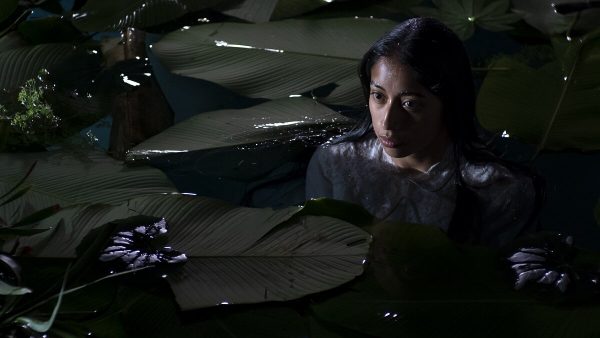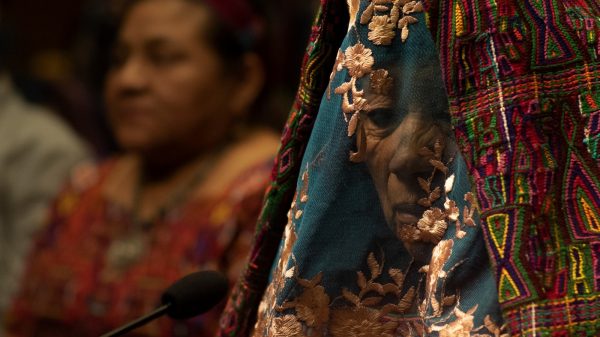Film Review: Shudder’s “La Llorona” — A Supernatural Reckoning with Guatemalan Genocide
By Isaac Feldberg
La Llorona’s deepest horrors flow from real history, from the atrocities inflicted by powerful men and the institutions established to ensure they get away with it.

A scene from La Llorona.
Ghosts gather at the edges of Jayro Bustamante’s exquisitely ominous La Llorona, a postcolonial parable that reimagines the Latin-American myth of the weeping woman as a force for truth and reconciliation in post-Civil War Guatemala. (In other words – and unlike the weeping woman’s last cinematic outing, WB’s water-logged Conjuring spinoff – Bustamante’s film, now streaming on Shudder, is more supernaturally charged allegory than assembly-line jump-scare generator.)
The ghosts in question – silent, glowering, sometimes eerily obscured or abstracted – first take the form of spectators packed into the courtroom where an old Guatemalan general, Enrique Monteverde (Julio Díaz), is standing trial for ordering genocide against the Mayan-Ixil people in the early ‘80s. They watch, eyes hollowed, surrounding the accused on all sides. When Monteverde is found guilty, only to be acquitted and released back to his family estate, there’s a similarly haunted mood to the sea of protestors outside, lifting high photographs of their “disappeared” loved ones, singing songs or more often simply staring powerfully up at those looking over the estate’s walls.
Inside his home, Monteverde is granted no quarter from the gravity of his crimes. As in Issa López’s similarly structured, equally superlative Tigers Are Not Afraid from last year, reckoning is imminent and inevitable, however you might think you’ll evade it. The guilty verdict has awakened something in his proud wife Carmen (Margarita Kénefic) and inquisitive daughter Natalia (Sabrina De La Hoz), suspicions that were perhaps always there, nestled deep. Suddenly these latent doubts and apprehensions dig into their sides like thorns. After the trial, the two women sit together in a room awash with empty white chairs, one security guard looming like a daubed specter in the far background. Natalia presses her mother about how much she knew, or chose to know, about Enrique’s so-called “womanizing” during the war. Carmen’s attempts to explain it away become terse. “We must move on for the country to go on,” says Carmen, finally. “What’s in the past, is in the past. If we look back, we will turn into salt statues.”
But the past is never in the past, and she knows this. It’s in the protest flyers raining down on the backyard pool, in the peeling wallpaper and rotted skeleton of their blood mansion. It fills the anguished eyes of maids as they tend to the encroaching senility – and lecherous proclivities, we learn – of a man who massacred their kinfolk, who’s just been exonerated in the eyes of the court. And it’s driving the look of fear and disgust that flits across Carmen’s features when young Sara (Ayla-Elea Hurtado) asks her, “Why do people say bad things about my grandpa?”
Outside, unseen protesters lift signs. Their disembodied chants rise like a howling wind through empty corridors of the general’s domicile. “There’s no peace without justice,” they shout, and the whole household hears it. Carmen, quietly in crisis, dreams that she’s caught in the midst of her husband’s atrocities, hopelessly dragging two Mayan children through a jungle, away from unseen forces that will soon visit unspeakable violence upon them all. Then from out of the thronged masses steps a young indigenous woman with long dark hair and huge, accusing eyes. Her name is Alma (María Mercedes Coroy), from the Spanish for “soul,” and she approaches Enrique’s household with an offer to serve as their maid. They are not in a position to refuse.
It’s worth noting at this juncture that, with his weather-beaten features and ash-white mustache, Enrique is not-so-subtly modeled after Guatemalan dictator Efraín Ríos Montt, who was convicted in 2013 of genocide and crimes against humanity, only to see that verdict annulled soon after by Guatemala’s constitutional court. La Llorona’s deepest horrors flow from real history, from the atrocities inflicted by powerful men and the institutions established to ensure they get away with it. In most versions of the la llorona myth, a woman, abandoned by her husband, drowns her children in a river and then kills herself, becoming cursed thereafter to haunt the earth forever. By shifting guilt from the devastated woman to the man responsible, Bustamante (and co-writer Lisandro Sanchez) not only update the folklore with considerable skill but could be seen as affording it a measure of corrective justice.
Consider the helplessness of the maids in Enrique’s home, Alma huddled among them as a silent witness. One night, plagued by sobs only he can hear, the general spies in on their quarters with a gun in hand, fantasizing that he sees Alma bathing. When his wife and daughter jolt him from this reverie, they notice the patriarch’s ghastly, telling erection. Even in the throes of dementia, a pitiful and decaying figure, Enrique remains a threat. Carmen admits at one point her suspicions that loyal maid Valeriana (María Telón) is her husband’s child by rape, proof of his so-called weakness for “native girls.” As Carmen’s time-honored defenses of her husband splinter into contempt and fury, so too does the emotional insulation her marriage secured her.

A scene from La Llorona.
That’s not to say that Alma is the weeping woman, per se, or even that La Llorona registers most strongly as a modern retelling of the legend. Bustamante is after something more complicated and intellectual, repurposing the visual language of psychological horror with its quietly fluid camerawork and phantasmic depths to suggest not only individuals but an entire nation haunted by its traumatic history. Like Mati Diop’s sublime Atlantics, which channeled Senegalese folklore into a ghost story of migrants drowned at sea and mysteriously returned to seek revenge on their oppressors, La Llorona sees its apparitions as the only avatar of justice for those struggling beneath the long arm of the colonial-capitalist state, the supernatural intervening to heal a broken world. There’s a magical realism to both films that also recalls the writing of Gabriel García Márquez, an ultimately hopeful suggestion that, while the only forces that can stand against the corruption of our world are spirits existing around and outside of it, there is no escaping these spirits, no reprieve, no mercy.
In a transfixing courtroom sequence, one Ixil woman details the atrocities committed against her on Enrique’s orders, wearing a t’zute to conceal her face. Bustamante stages this using a backward zoom that begins on her covered features, before pulling back to reveal the gallery hanging on every devastating word – including Monteverde and his family, all gradually implicated. Only after the court delivers its verdict does this woman, along with dozens like her, reveal her face to the world, the veil falling away, its purpose served.
Throughout, Bustamante stages similar tableaus – from the dimly lit corners of the general’s home, to the dark waters of their baths and backyard pool – to craft a film of potently subconscious compositions, focusing on opaque surfaces that we know harbor unimaginable sorrow and rage. In league with cinematographer Nicolás Wong Díaz, Bustmante has concocted a hazy, nightmarish style: genre-savvy enough to work in split-field diopters and wakes of sinuous smoke, but restrained enough to keep the tension grounded in psychological rather than technical fields. La Llorona is too well-considered a film to lean on jump-scares, though its shrouds and shadows are impossibly freighted. Bustamante serves up a gripping third act, including the revelation that la llorona’s work has only just begun. But it’s the film’s atmosphere of foreboding and dread, its suffocating pall of communal grief and familial guilt, that lingers most. And that’s right for a film this coldly furious, one that succeeds as both a shattering requiem for those disappeared souls of Guatemala and as a keening wail of a picture, carrying forth their memory in search of a karmic justice the world has left undone.
Isaac Feldberg is an entertainment journalist currently based in Boston. Though often preoccupied by his on-going quest to prove that Baby Driver is a Drive prequel, he always finds time to appreciate the finer things in life, like Michael Shannon.

